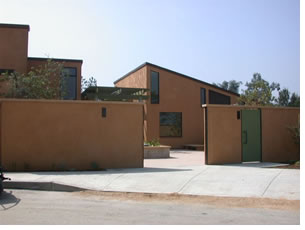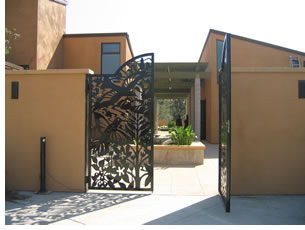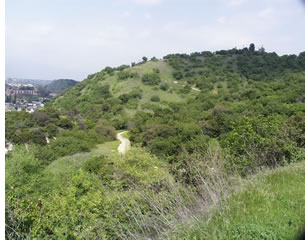

Audubon LEED™-ing the Way to Sustainability in LA
 The
Audubon Center at Debs Park near Los Angeles debuted November 7 as the
Audubon Society’s first nature center in California constructed
from the ground up using environmentally sensitive design techniques.
Design for the new building fits within the guidelines of the U.S. Green
Building Council’s LEED (Leadership in Energy and Environmental
Design) Green Building Rating System™. A team of Green Building
Council affiliates worked hand-in-glove with the owner to give life to
the new center. Campbell and Campbell of Santa Monica created the master
plan and the landscape architecture designs for the 200-acre park. The
deft touch of the venerable Esherick Homsey Dodge & Davis Architects
of San Francisco graces the building design. Soltierra coordinated the
LEED™ documentation and submission, TG Construction served as general
contractor, and BOVIS Lend-Lease acted as the owner’s representative.
All told, more than 20 other firms also provided design and construction
services.
The
Audubon Center at Debs Park near Los Angeles debuted November 7 as the
Audubon Society’s first nature center in California constructed
from the ground up using environmentally sensitive design techniques.
Design for the new building fits within the guidelines of the U.S. Green
Building Council’s LEED (Leadership in Energy and Environmental
Design) Green Building Rating System™. A team of Green Building
Council affiliates worked hand-in-glove with the owner to give life to
the new center. Campbell and Campbell of Santa Monica created the master
plan and the landscape architecture designs for the 200-acre park. The
deft touch of the venerable Esherick Homsey Dodge & Davis Architects
of San Francisco graces the building design. Soltierra coordinated the
LEED™ documentation and submission, TG Construction served as general
contractor, and BOVIS Lend-Lease acted as the owner’s representative.
All told, more than 20 other firms also provided design and construction
services.
 Going
for the Platinum
Going
for the Platinum
Audubon is seeking a platinum rating from the council—the highest
rating available—for the Debs Park facility. To meet the stringent
requirements, the building must earn a minimum of 52 “sustainability
points”—awarded for everything from site selection to indoor
environmental quality—out of an available 69. Audubon is seeking
to earn 55 points. The Audubon Center at Debs Park is just one of three
buildings in Southern California currently seeking the Platinum rating
and, if awarded, will be the first facility in the country to have received
this distinction under the new 2.1 version of LEED™ in the New Construction
class.
The design of the Audubon Center at Debs Park focuses on key environmental issues at the very heart of sustainable building: alternative energy sources, including solar power; water conservation; recycled building materials; and native landscaping. The 5,023 square-foot building will be Los Angeles’ first entirely powered by on-site solar systems—functioning off the grid. It also will use 70 percent less water than a conventional building of its size. More than 50 percent of the building materials will be locally manufactured—2.5 times that required to achieve a LEED™ credit. And more than 90 percent of construction debris generated will be recycled. “Because we are entirely solar-powered, we’ll save $5,000 per year on electricity alone, says Elsa Lopez, director of the Audubon Center at Debs Park.
 All
elements of the project, from the renewable sisal carpets on the floors
to the top of the pergolas, add up to a super-efficient building. The
ground-face concrete block walls, exposed on the interior and stuccoed
on the outside, are cemented with grout containing 25–50 percent
flyash, a recycled waste product of coal burning. Their steel rebar reinforcement
boasts 100 percent recycled material, including melted down guns traded
in to the City of Los Angeles. The dark, earth-toned exterior blends in
with the hillside and complements the solar arrays, which include 200
photovoltaic panels hooked to batteries that can store three days’
worth of power. The building’s plywood and redwood for its pergolas
all comes from sustainably managed forests, as certified by the Forest
Stewardship Council.
All
elements of the project, from the renewable sisal carpets on the floors
to the top of the pergolas, add up to a super-efficient building. The
ground-face concrete block walls, exposed on the interior and stuccoed
on the outside, are cemented with grout containing 25–50 percent
flyash, a recycled waste product of coal burning. Their steel rebar reinforcement
boasts 100 percent recycled material, including melted down guns traded
in to the City of Los Angeles. The dark, earth-toned exterior blends in
with the hillside and complements the solar arrays, which include 200
photovoltaic panels hooked to batteries that can store three days’
worth of power. The building’s plywood and redwood for its pergolas
all comes from sustainably managed forests, as certified by the Forest
Stewardship Council.
 Urban
oasis
Urban
oasis
Debs Regional Park, a 282-acre urban wilderness just 10 minutes’
drive northeast of downtown LA, shelters wildlife from coyotes to 138
species of birds, according to the Audubon Society. Yet some of the city’s
densest urban neighborhoods surround it. Within a two-mile radius, 50,000
young people, predominantly Latino, will have the opportunity to enjoy
the site’s natural beauty. The landscape plan, which encompasses
restored native plants, an interpretive trails system, and interior courtyards,
embodies the concept of “nature in the city” to teach how
people and nature can exist side-by-side.
The Audubon Center at Debs Park joins the growing network of green Audubon Centers across the country. In 1990, the National Audubon Society began its commitment to green building practices by restoring and refurbishing New York City’s historic Schermerhorn Building to serve as the organization’s headquarters. The Audubon House, designed by the Croxton Collaborative, still commands the building industry’s respect as a prime example of urban sustainable design.
Copyright 2003 The American Institute of Architects.
All rights reserved. Home Page ![]()
![]()
 |
||
| Read more
about Debs Park Audubon Center. Learn more about the Audubon Society. Photos courtesy of the Audubon Society.
|
||